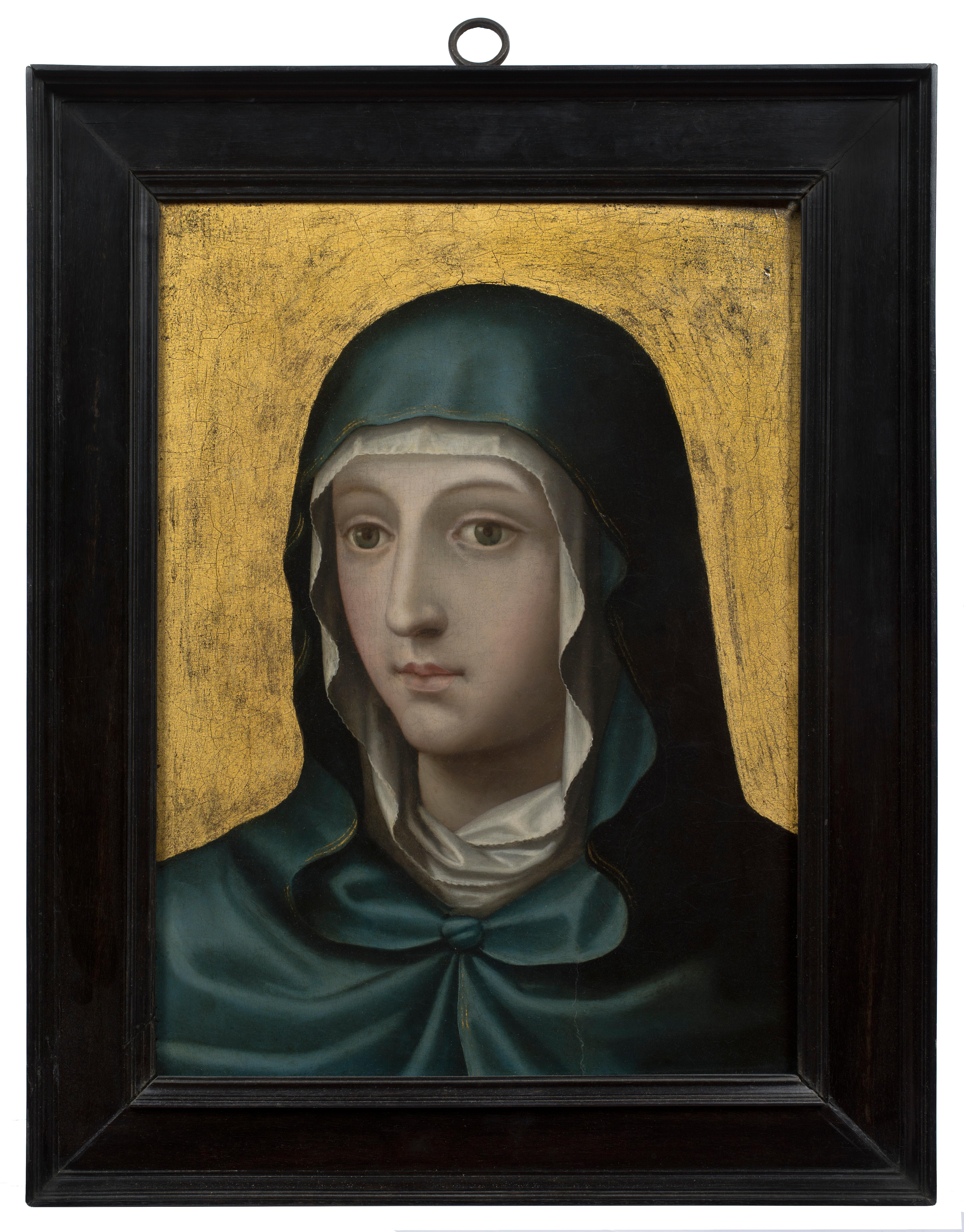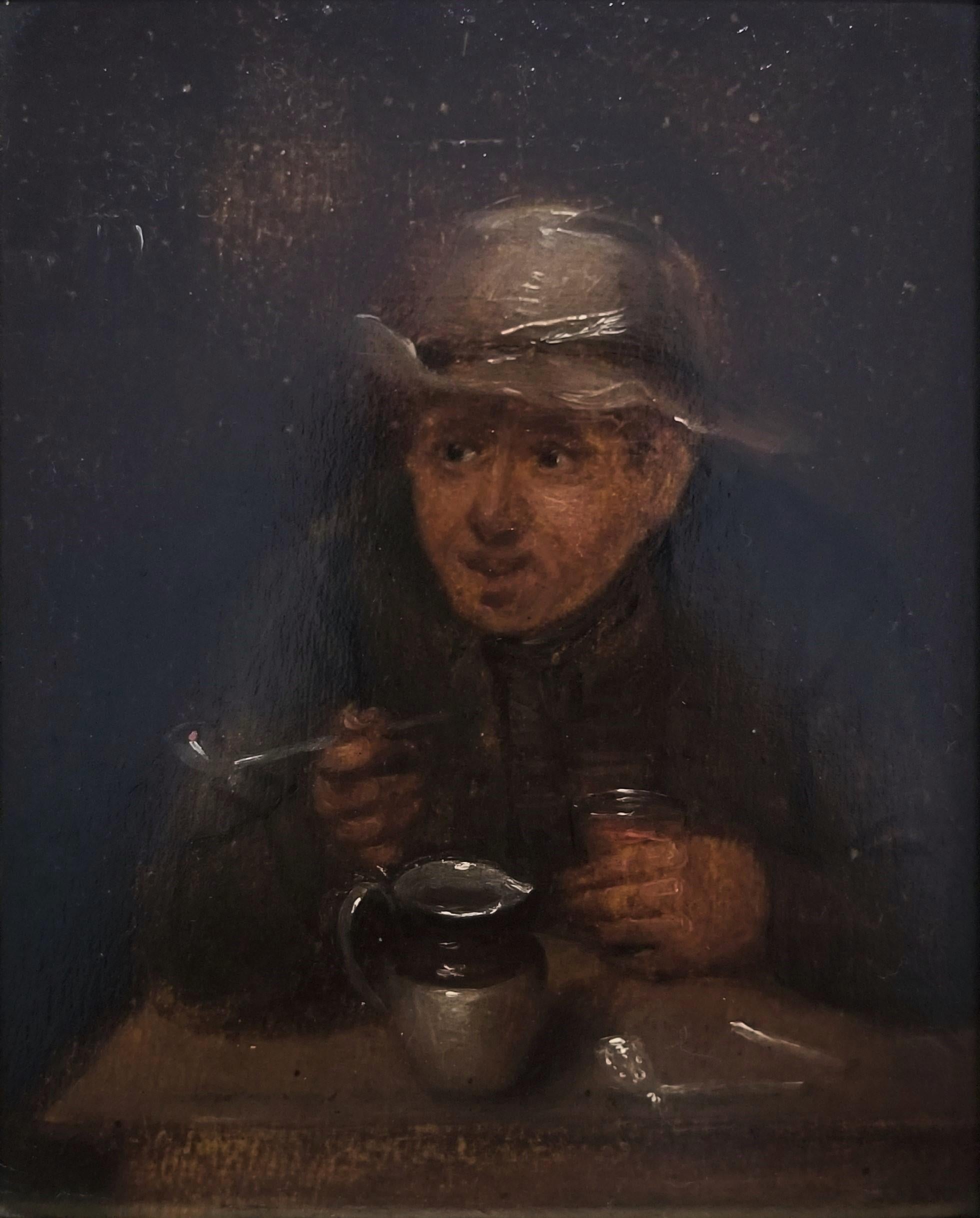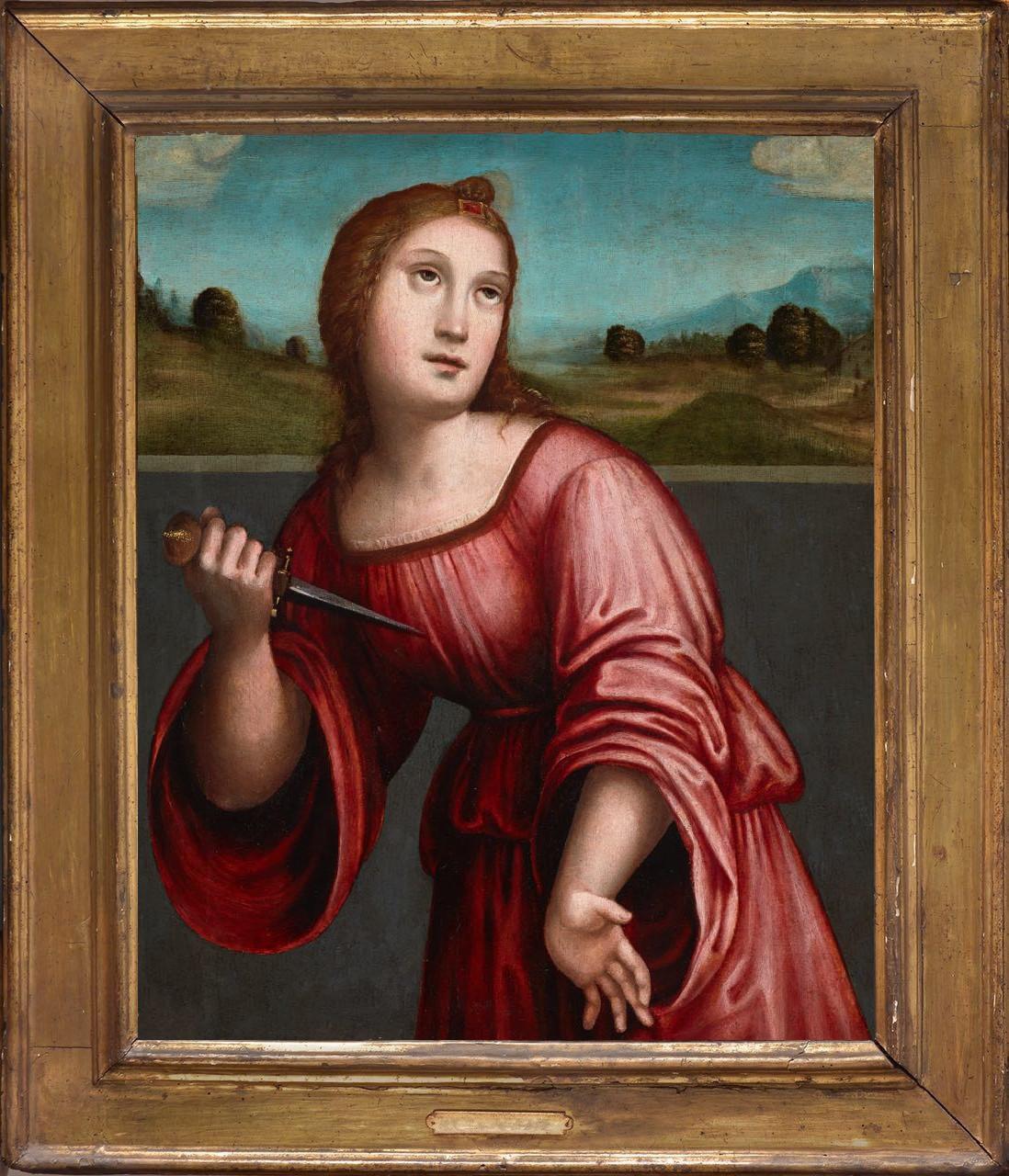Items Similar to The Pearl Lady, Oil on board signed Honthorst, dated 1644
Want more images or videos?
Request additional images or videos from the seller
1 of 11
Gerard van HonthorstThe Pearl Lady, Oil on board signed Honthorst, dated 1644 1644
1644
About the Item
The Pearl Lady, most probably Elisabeth of Bohem, Princess Palatine.
Oil on board signed Honthorst, dated 1644
Within a beautiful tortoise shell
With a certificate by René Millet ( Well Known French Expert in Paris)
The young unknown portrait shows the talent of the artist. We will appreciate the quality of glazed face, the light in the beads and the psychological analysis of the model. We almost read the character of the model. This type of face is found throughout the valley of the Rhin, Switzerland, the Netherlands.
Our beauty is flirtatious and love beautiful pearls, symbol of fidelity. And so the large barocco pearl, the earrings, the necklace, the adornment in her hair; all attest of the prosperity.
Gerrit Van Honthorst was born in 1590 and died 1656.
His career is divided into two very different parts.
In the first part of his life he is The “Night Master”, "Cavaragesque" painter, that the Italian nicknamed GUERARDO OF THE NOTTE. This period mainly Roman, which will influence LA TOUR and REMBRAND overshadowed the rest of his work.
Indeed, it has been forgotten today; but when GUERARDO DE LA NOTTE returned to Utrecht, he became a fashionable portrait's painter. Radical changes without knowing the real reasons although it is often forgotten that a painter like everyone needs to survive ... Especially since the death of Van Dyck has opened the road to our artist who will rush into exploiting it. He is called to the court of Charles I, in London, where he will paint the king and the nobles of the court. In 1637, he moved to The Hague and become Van Dyck's official successor for the Netherlands and all Europe.
Gerrit van Honthorst’s night paintings caused such a sensation in Rome that he was known as Gherardo delle Notti (Gerard of the Night Scenes). An Utrecht native and son of a painter of tapestry cartoons, Honthorst’s reputation was made with these nocturnal pictures, usually religious subjects. A single candle served as the light source whose rays were shielded by the figures. The lighting was derived from Caravaggio’s works, and Honthorst’s role in bringing knowledge of Caravaggio and his followers to the North was critical; many painters, including Rembrandt van Rijn and Georges de la Tour, were influenced by Honthorst’s Caravaggesque pictures.
After nearly ten years in Rome, Honthorst settled in Utrecht in 1620, where he soon abandoned his Caravaggesque manner and adopted a much lighter palette. In 1628 he was called to England to paint the royal family. There he began his second, court style, painting portraits in the manner of Anthony Van Dyck. Honthorst spent the rest of his career as court painter at The Hague, where he largely devoted himself to portraits, becoming one of the few seventeenth-century Dutch artists to earn an international reputation. He also painted large-scale, decorative works influenced by Peter Paul Rubens and the Carracci.
Currently, the portrait, especially of the seventeenth century is overlooked and yet it offers the last opportunity to buy at low prices the work of a great master.
Excellent condition. Painting was only cleaned and re-varnished
Height: 74 cm / 29 inches Width: 59cm / 23.2 inches (without Frame)
Height: 92 cm / 36.22 inches Width: 76cm / 29.9 inches Depth: 8cm / 3.14 inches (with Frame)
- Creator:Gerard van Honthorst (1592 - 1656, Dutch)
- Creation Year:1644
- Dimensions:Height: 29.14 in (74 cm)Width: 23.23 in (59 cm)Depth: 1.19 in (3 cm)
- Medium:
- Movement & Style:
- Period:
- Condition:
- Gallery Location:Paris, FR
- Reference Number:
About the Seller
5.0
Vetted Seller
These experienced sellers undergo a comprehensive evaluation by our team of in-house experts.
1stDibs seller since 2019
8 sales on 1stDibs
- ShippingRetrieving quote...Ships From: Paris, France
- Return PolicyA return for this item may be initiated within 14 days of delivery.
More From This SellerView All
- Children playing in the park, oil on canvas signed Joseph Dierickx dated 1903By Joseph DierickxLocated in Paris, FRA "genre" painting representing a mother supervising her two small daughters at the Park. Oil on canvas signed bottom right Joseph Dierickx and dated 1903. Dierickx Joseph (1865-19...Category
Early 20th Century Academic Figurative Paintings
MaterialsCanvas
- Portrait of Young Boy, Oil on Canvas Signed Felix Bryk, circa 1910Located in Paris, FRLovely portrait of a young Boy standing on an armchair. Oil on canvas signed Felix BRYK. Swedish School, circa 1900-1910 Portraitist and ethnologist of the early twentieth century. ...Category
1910s Academic Portrait Paintings
MaterialsCanvas
- Young Woman With A Rose Signed Grandin Dated 1888Located in Paris, FRPortrait of a young woman holding a rose. Oil on canvas signed Grandin and dated 1888. French School XIXth Century Dimensions: 80 x 21.5 cm ( 31.496 x 8.268 inches) Dimensions wi...Category
1880s French School Portrait Paintings
MaterialsOil
- The Flight of the Holy Family to Egypt, Oil on canvas, Italian school circa 1680Located in Paris, FRThe Flight into Egypt, an episode of childhood of Christ in the New Testament, representing Joseph, Mary and Jesus on a donkey, fleeing from Palestine to Egypt, at the behest of the ...Category
17th Century Old Masters Interior Paintings
MaterialsCanvas
- Mediterranean Capriccio, Oil on canvas by Abraham Storck, circa 1680By Abraham Jansz StorckLocated in Paris, FR« A Mediterranean capriccio » Oil on canvas by Abraham STORCK With an appraisal by René Millet ( Well Known French Expert in Paris) Within a tortoise-shell Turtle This oil on canvas...Category
17th Century Old Masters Landscape Paintings
MaterialsCanvas
- Waterfall landscape signed Eugène Deterre, Bruges circa 1830Located in Paris, FRPainting, oil on panel depicting an animated landscape with river and waterfall. Signed Deterre Eugene (1810-1842) and located Brugges. Flemish School, circa 1830 Belgian. WithIn ...Category
1830s Academic Landscape Paintings
MaterialsWood Panel
You May Also Like
- The Veronica of the Virgin (Verónica de la Virgen)Located in New York, NYThe panel has been attributed both to Joan de Joanes and his son Vicente Macip Comes (Valencia, ca. 1555 – 1623). Provenance: Private Collection, England, by 1886 (according to stencils on the reverse) Private Collection, New Jersey, until 2010 The Veil of Veronica, often called the Sudarium, is one of the most important and well-known relics of Christ. According to legend, Veronica offered Christ her veil as he carried the cross to his crucifixion. He wiped his face with the veil, which left the cloth miraculously imprinted with his image. Depictions of Christ’s face on a veil, or simply images that focused in on Christ’s face, were treasured objects of religious devotion. The popularity of this format also inspired similar images of the face of the Virgin. The iconographic type of the present painting is known as the Veronica of the Virgin, which was especially favored in late medieval and early Renaissance Spain. Distinct from the images of the suffering Christ, the Veronica of the Virgin is based on the legend that Saint Luke painted a portrait of Mary from life. Although scholars have sometimes mistaken them for portraits of Queen Isabella I of Castile (known as Isabel la Católica) or as a depiction of Saint Maria Toribia (known as María de la Cabeza, or, Mary of the Head), paintings like this one were clearly intended as images of the Virgin in the style of Saint Luke’s lost portrait. The Veronica of the Virgin was especially popular in Valencia, and depictions of this subject produced there all stem back to one visual prototype: a Byzantine image in the city’s cathedral (Fig. 1). This early treatment of the Veronica was given to the cathedral in 1437 by Martin the Humane, King of Aragon and Valencia, who promoted religious veneration of the Veronica of the Virgin as part of the celebration of the Immaculate Conception of Mary. This devotion spread throughout Martin’s kingdom and particularly took hold in Valencia, where the Byzantine image resided. The image, which is displayed in a gold reliquary...Category
16th Century Old Masters Paintings
MaterialsOil, Wood Panel
- 18th century portrait of the painter Nathaniel DanceLocated in London, GBCollections: Robert Gallon (1845-1925); Private Collection, UK. Oil on canvas laid down on panel Framed dimensions: 11.5 x 10 inches This highly engaging, previously unpublished portrait by Johan...Category
18th Century Old Masters Portrait Paintings
MaterialsCanvas, Oil, Wood Panel
- Man in Tavern Smoking a Pipe /// Old Masters Dutch David Teniers Portrait FaceBy David Teniers the YoungerLocated in Saint Augustine, FLArtist: Unknown (Circle of David Teniers the Younger, Flemish, 1610-1690) Title: "Man in Tavern Smoking a Pipe" *No signature found Circa: 1690 Medium: Original Oil Painting on Wooden Board Framing: Framed in an antique gold gesso frame...Category
1690s Old Masters Portrait Paintings
MaterialsGold Leaf
- Portrait of a Lady Diana Cecil, Countess of Elgin c.1638, Manor House ProvenanceLocated in London, GBTitan Fine Art present this picture which formed part of a historic collection of an English aristocratic family, Lord and Lady Sandys at their magnificent baroque and Regency Grade-...Category
17th Century Old Masters Portrait Paintings
MaterialsOil, Wood Panel
- Lucretia, by Giacomo Raibolini Francia. Detto il Francia. Oil on panel, framedLocated in Brooklyn, NYGiacomo used to paint with his brother Giulio, identifying their works with the monogram «I I». The strong influence of his father, Francesco, is undeniable in all his works, althoug...Category
16th Century Old Masters Figurative Paintings
MaterialsOil, Wood Panel
- Portrait of William Herbert, 3rd Earl of Pembroke, Early 17th Century PortraitLocated in London, GBEnglish School, (circa 1600) Portrait of William Herbert, 3rd Earl of Pembroke Oil on panel, oval Image size: 29¼ x 23⅞ inches Painted wooden frame Provenance: 176, Collection of Francis Greville, 1st Earl of Warwick. The Trustees of the Lord Brooks’ Settlement, (removed from Warwick Castle). Sotheby’s, London, 22nd March 1968, lot 81. Painted onto wooden panel, this portrait shows a dark haired gentleman in profile sporting an open white shirt. On top of this garments is a richly detailed black cloak, decorated with gold thread and lined with a sumptuous crimson lining. With the red silk inside it’s all very expensive and would fall under sumptuary laws – so this is a nobleman of high degree. It’s melancholic air conforms to the contemporary popularity of this very human condition, evident in fashionable poetry and music of the period. In comparison to our own modern prejudices, melancholy was associated with creativity in this period. This portrait appeared in the earliest described list of pictures of Warwick castle dating to 1762. Compiled by collector and antiquary Sir William Musgrave ‘taken from the information of Lord & Lady Warwick’ (Add. MSS, 5726 fol. 3) is described; ‘8. Earl of Essex – an original by Zuccharo – seen in profile with black hair. Holding a black robe across his breast with his right hand.’ As tempting as it is to imagine that this is a portrait of Robert Devereux, the 2nd Earl Essex, we might take this with a pinch of salt. Its identification with this romantic and fatal Elizabethan might well have been an attempt to add romance to Warwick Castle’s walls. It doesn’t correspond all that well with Essex’s portraits around 1600 after his return from Cadiz. Notably, this picture was presumably hung not too far away from the castle’s two portraits of Queen Elizabeth I. The first, and undoubtedly the best, being the exquisite coronation portrait that was sold by Lord Brooke in the late 1970s and now hangs in the National Portrait Gallery. The second, described as being ‘a copy from the original at Ld Hydes’, has yet to resurface. The portrait eventually ended up being hung in the State Bedroom of Warwick Castle. Archival documents present one other interesting candidate. The Greville family’s earliest inventory of paintings, made in 1630 at their home Brooke House in Holborn, London, describes five portraits of identified figures. All five belonged to the courtier, politician and poet Sir Fulke Greville (1554-1628), 1st Baron Brooke, and were hung in the ‘Gallerie’ of Brooke House behind yellow curtains. One of them was described as being of ‘Lord of Pembrooke’, which is likely to have been William Herbert (1580-1630), 3rd Earl of Pembroke. William was the eldest son of Greville’s best friend’s sister Mary Sidney, and was brought up in the particularly literary and poetically orientated household which his mother had supported. Notably, the 3rd Earl was one of the figures that Shakespeare’s first folio was dedicated to in 1623. The melancholic air to the portrait corresponds to William’s own pretensions as a learned and poetic figure. The richness of the robe in the painting, sporting golden thread and a spotted black fabric, is indicative of wealth beyond that of a simple poet or actor. The portrait’s dating to around the year 1600 might have coincided with William’s father death and his own rise to the Pembroke Earldom. This period of his life too was imbued with personal sadness, as an illicit affair with a Mary Fitton had resulted in a pregnancy and eventual banishment by Elizabeth I to Wilton after a short spell in Fleet Prison. His illegitimate son died shortly after being born. Despite being a close follower of the Earl of Essex, William had side-stepped supporting Devereux in the fatal uprising against the Queen and eventually regained favour at the court of the next monarch James I. His linen shirt is edged with a delicate border of lace and his black cloak is lined on the inside with sumptuous scarlet and richly decorated on the outside with gold braid and a pattern of embroidered black spots. Despite the richness of his clothes, William Herbert has been presented in a dishevelled state of semi-undress, his shirt unlaced far down his chest with the ties lying limply over his hand, indicating that he is in a state of distracted detachment. It has been suggested that the fashion for melancholy was rooted in an increase in self-consciousness and introspective reflection during the late 16th and early 17th centuries. In contemporary literature melancholy was said to be caused by a plenitude of the melancholy humor, one of the four vital humors, which were thought to regulate the functions of the body. An abundance of the melancholia humor was associated with a heightened creativity and intellectual ability and hence melancholy was linked to the notion of genius, as reflected in the work of the Oxford scholar Robert Burton, who in his work ‘The Anatomy of Melancholy’, described the Malcontent as ‘of all others [the]… most witty, [who] causeth many times divine ravishment, and a kind of enthusiamus… which stirreth them up to be excellent Philosophers, Poets and Prophets.’ (R. Burton, The Anatomy of Melancholy, London, 1621 in R. Strong, ‘Elizabethan Malady: Melancholy in Elizabethan and Jacobean Portraits’, Apollo, LXXIX, 1964). Melancholy was viewed as a highly fashionable affliction under Elizabeth I, and her successor James I, and a dejected demeanour was adopted by wealthy young men, often presenting themselves as scholars or despondent lovers, as reflected in the portraiture and literature from this period. Although the sitter in this portrait is, as yet, unidentified, it seems probable that he was a nobleman with literary or artistic ambitions, following in the same vain as such famous figures as the aristocratic poet and dramatist, Edward de Vere...Category
Early 17th Century Old Masters Portrait Paintings
MaterialsWood Panel, Oil
Recently Viewed
View AllMore Ways To Browse
The Antique Pearl
Prices On Antique
Old Italian Sign
Wood Old Signs
Old Pictures
Antique Open Sign
Antique Sign Board
Two Oil Paintings On Board
Lady Light
Ten Works Ten Painters
Oil Pearls
Old Scales Antique
Old Antique Scale
Old Antique Scales Scales
Old Antique Scales
La Tour
Royal Board Paintings
Large Antique Wood Signs




